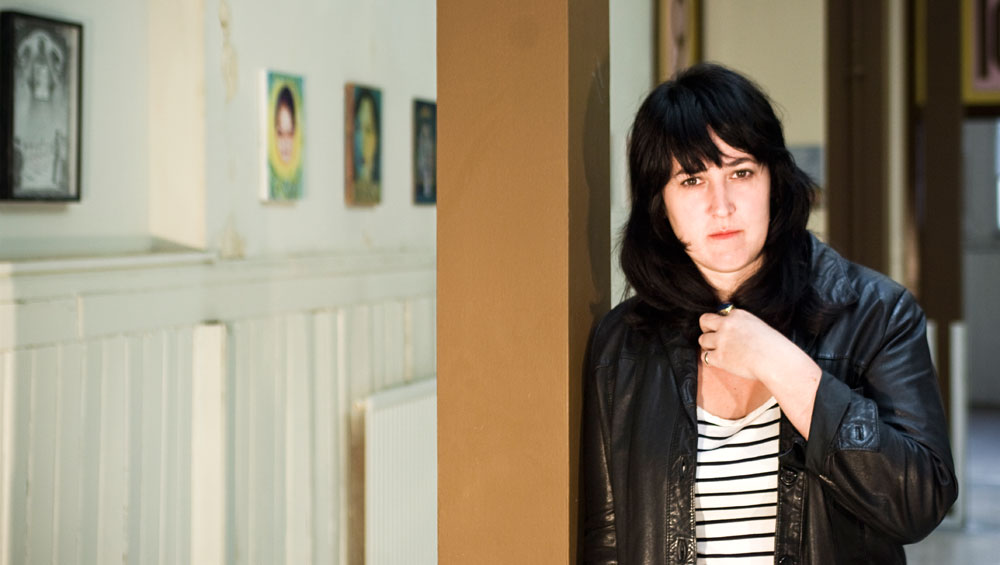
by ANNA McNAY
Tamsyn Challenger is an artist whose practice responds to violations of human and women’s rights around the world. Her collective gender-political portrait, 400 Women (2010), was made following a visit to Mexico in 2006, where she met with the mothers and families of women who had been brutally raped and murdered or who had disappeared, in the town of Ciudad Juarez. Her current curatorial venture, Free the Pussy!, at Edinburgh’s Summerhall, comprises works made in response to – and representing the core issues relating to – the arrest in 2012 of Pussy Riot, following their pop-up protest performance, Punk Prayer, at Moscow’s Cathedral of Christ the Saviour, which attacked the Orthodox church’s support for the Russian president, Vladimir Putin. Featuring works by the likes of Judy Chicago, Yoko Ono and Carolee Schneemann, the exhibition also includes Challenger’s own work, Ducking Stool (2012).
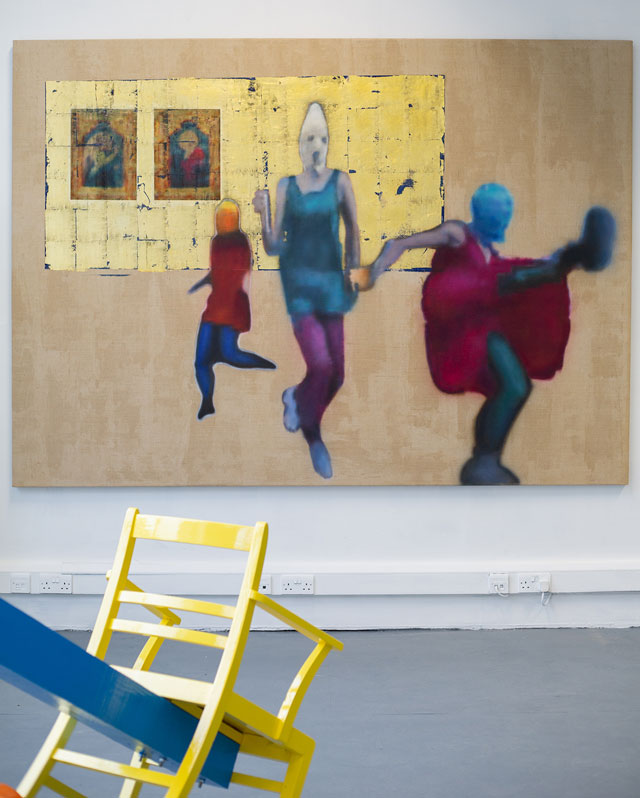
Free The Pussy, installation view. Photograph: Cat Thomson.
Studio International spoke to Challenger about the origins of the exhibition, the roles of the artist-curator and the female artist in contemporary society, and the need for women to reclaim and own powerful words, such as “pussy” and “cunt”.
Anna McNay: You have just curated the exhibition, Free the Pussy!, largely comprising works of art made in response to Pussy Riot’s imprisonment by the Russian government in 2012. You’re also an artist in your own right, and are showing work there alongside the likes of Judy Chicago, Yoko Ono and Carolee Schneemann.
Tamsyn Challenger: Artist-curator – it’s a thing right now, isn’t it? There’s that great [John] Baldessari quote where he suggested that curators use artists like paint pots. So, I think it’s important that artists take a bit more control, when they’re offered it. I have found curating really interesting. Maybe I do just want to control things more. That’s something I need to question myself on, I suspect, but it’s quite a joy to be able to really let yourself be free to control all aspects of an exhibition. There are always people who want to obstruct that, particularly when the curator is a female artist. So it’s nice to get a bit of power.
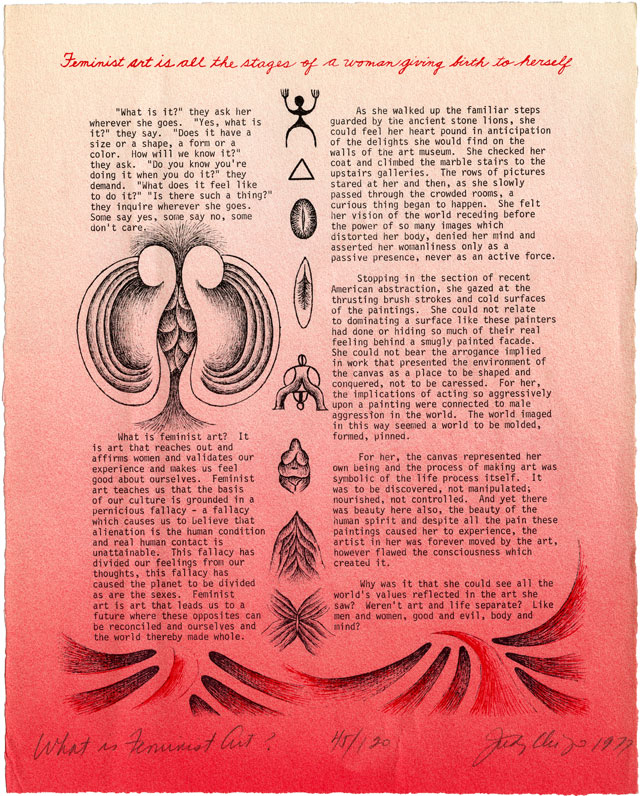
Judy Chicago. What is Feminist Art? 1977.
AMc: And to be able to work with all these amazing people, who presumably have been artists you have looked up to in the past?
TC: The Yoko thing was an absolute blinking bucket list item. I adore Yoko! I was asked originally to contribute to the book, Let’s Start a Pussy Riot (2013), to which she was also a contributor, and that’s how a lot of this came about. So many other artists stood in protest at the Riot’s trial and imprisonment, however, so I opened it out to include more than just the artists represented in the book. There are a few in there that I asked to be a part of the show, too, though.
AMc: Let’s talk about the book briefly. It was published in 2013, but the idea was born straight after Pussy Riot were arrested for Punk Prayer in 2012?
TC: It was. The idea was to raise money for the trial. It was put together by Emely Neu and three London feminist collectives. 400 Women was just two years previous to that, so I suspect that was the reason for me being asked.
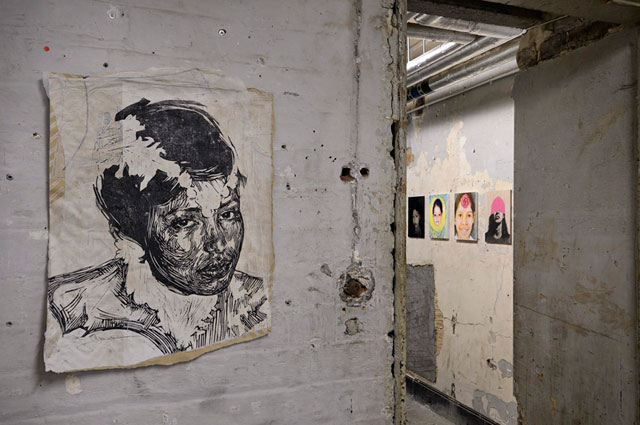
Tamsyn Challenger, 400 Women, 2010. Portraits by various artists. Installation view, Shoreditch Town Hall Basement, London, 2010. Central image by Swoon. Photograph: Paul Tucker.
AMc: Maybe we should go back a bit further and talk about 400 Women first, then? The press release for Free the Pussy! says this is your first curatorial endeavour, but I thought you curated 400 Women as well?
TC: The idea behind that was for a gender-political portrait show. It was always a conceptual work for me. The reason I didn’t want to paint all the works myself was because I needed other people to represent the individual. I needed to re-personalise each woman who had been brutally raped, violated, murdered and/or was missing. For me, that was fundamental to the concept. I couldn't have done it myself. It was reliant on each different personality and each different brushstroke. When it showed in London, some of the copy around the show was unhelpful to what it was actually about and perhaps cited me more in the role of curator. But it was an authored work with a collective response. I always envisaged it as a site-specific installation.
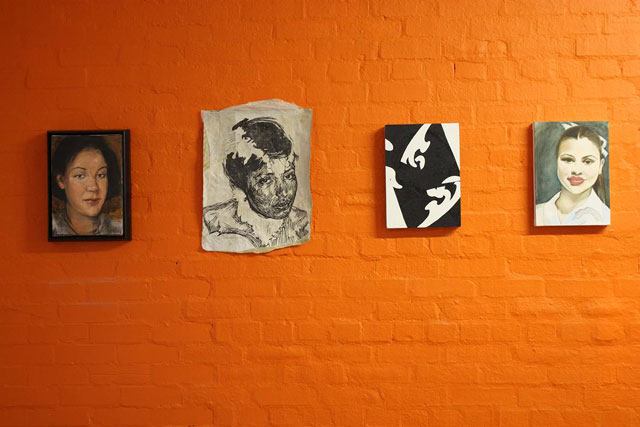
Tamsyn Challenger, 400 Women, 2010. Portraits by various artists. Installation view, Canongate Venture, Edinburgh Art Festival, 2011. Photograph: Albie Clark.
It came out of my experience in Mexico with the mothers and family groups of some of the murdered and missing women. On the plane home, I fully fleshed out in my head how the installation was going to work, but it took five years after that to come to fruition. Inevitably, there were curatorial aspects to that work, which have definitely come into play with Free the Pussy! I’m very brazen about approaching people and I treat people in a very egalitarian way. There is no hierarchy as far as I’m concerned.
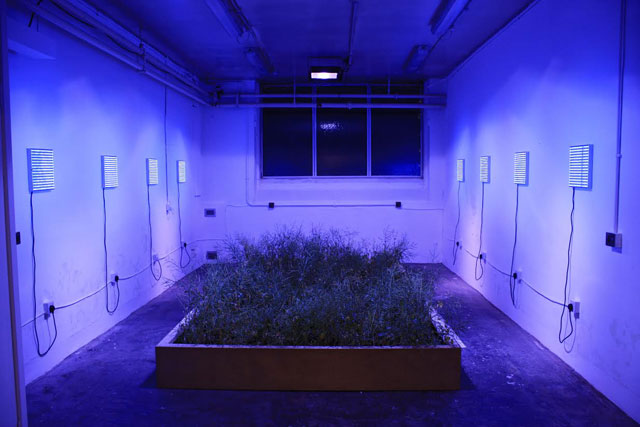
Tamsyn Challenger. Monoculture, 2014. Pine planter, soil, OSR, blue led grow lights. Installation view, Summerhall/EAF.
AMc: And, as you were saying, you think it was on the back of having done 400 Women that the collectives contacted you to participate in Let’s Start A Pussy Riot?
TC: Yes. I don’t want to speak for them because I don’t know why I was asked specifically to contribute, but that’s what I was most known for at that point. I was working on Monoculture by then [a project that grew out of her residency at Beaconsfield, London, under the curatorial direction of David Crawforth and Naomi Siderfin, from June 2012 to February 2013, and which explored cultural homogeneity and selfie culture], but I think that was a bit like my tricky second album. Free the Pussy! is my first unabashedly gender-political work since 400 Women.
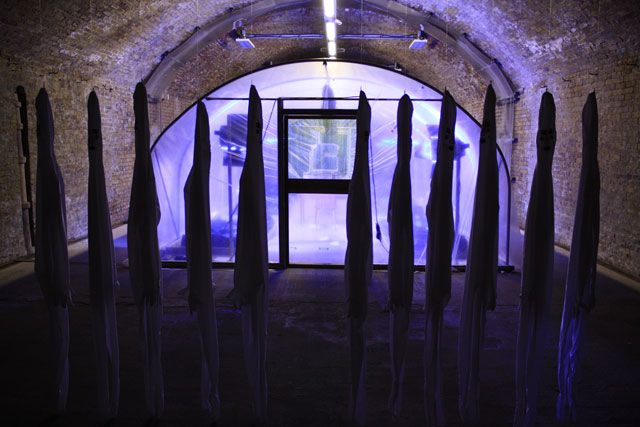
Tamsyn Challenger. Monoculture, 2013. Polytunnel, soil, OSR, blue led grow lights, zentai suits, embroidery silks. Installation view, Beaconsfield, Vauxhall.
AMc: When did you first become aware of Pussy Riot? Was it when they got arrested or were they on your radar before that?
TC: It was when they were arrested. But, subsequently, I have become aware of work by Voina [a Russian street art group, known for its politically charged performance works] that predates the Riot. I’ve included a Voina piece in the show because Nadya suggested it [Nadezhda Tolokonnikova, known as Nadya, was a member of Voina in its early years, but split from the original group in 2009, going on to become part of Pussy Riot, and was one of the three members arrested, convicted and sentenced for Punk Prayer. Yekaterina Samutsevich, also sentenced but released on probation, had also previously been a part of Voina]. It was a crucial decision. I polled opinion. It was the only piece I polled opinion on, because a lot of folk I showed it to initially struggled with it. I think it was the right thing to do to include it, however.
AMc: Why do you think people struggled with it?
TC: As one of its provocations, Voina went around kissing the Russian police and, while the piece is funny, it also makes people feel a bit uncomfortable. I had it levelled at me at one point that it was a bit anti-feminist. And, one of the things I have examined in Free the Pussy! – rather quietly behind the archive of protest – is what constitutes feminist art. There is a 1977 artwork by Judy Chicago, What is Feminist Art?, which was in the book Let’s Start a Pussy Riot. I think there’s a lot of arguing in feminism that is counterproductive to what we’re really all after – namely, equality. I would really like us all to collectively accept that people have slightly differing perspectives, not take our eye off the ball, and just push for the core, which is to try to get equal pay, have freedom of choice, and be at a point where a woman can be the president of the US.
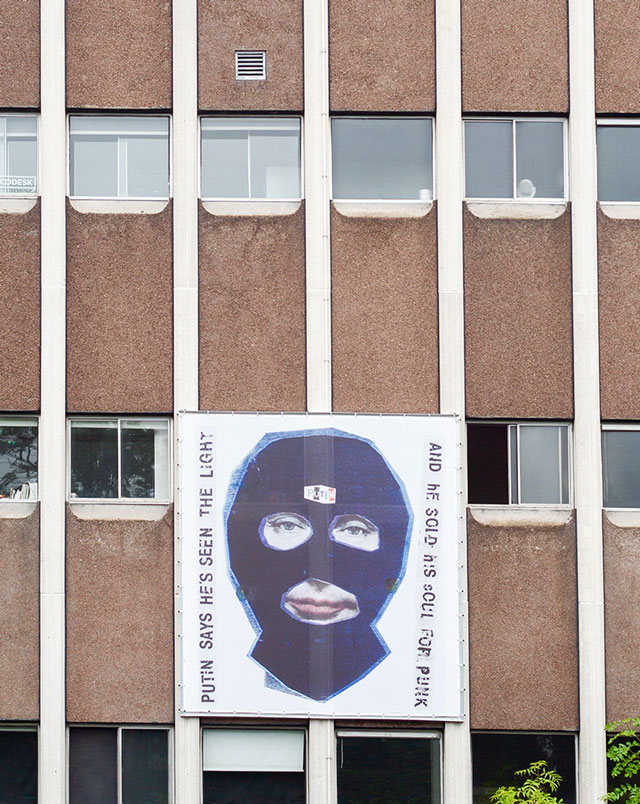
Jamie Reid. Free Pussy Riot poster 2012, adapted for Putin Trampoline external building sign, 2018.
AMc: How did the idea for Free the Pussy! come about? Was it purely that you were involved in the book and you thought this needed extending?
TC: I was told that Pussy Riot was coming to do Riot Days here in Edinburgh. Masha [Maria Alyokhina, the third member of Pussy Riot who was sentenced following Punk Prayer] wrote a book about her experiences – part-memoir, part-protest manual – and this is a punk, theatrical performance based on that, charting the group’s journey to becoming global icons of a new wave of activism. But, to be honest, when the book, Let’s Start a Pussy Riot, first came about, I thought it should be an exhibition. I remember saying it to one of the collectives at the time, but they wanted to make a book because it was for raising funds. It was a lofty ideal, and important, and that was great. But it was another thing to put an exhibition on. So, it just seemed the perfect opportunity to have things join up.
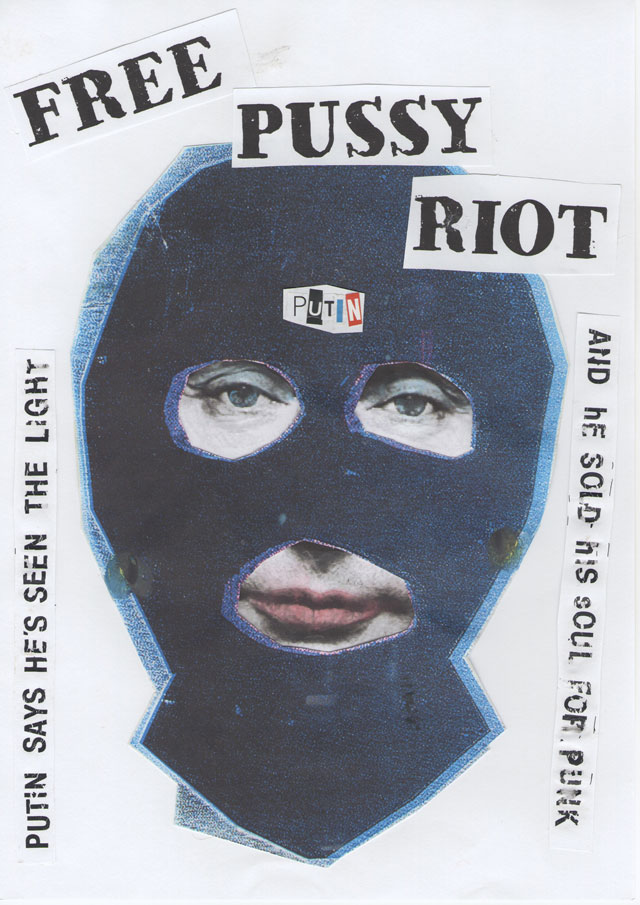
Jamie Reid. Free Pussy Riot, 2012.
AMc: Did you have a wish list of artists in your mind from the outset?
TC: The first thing I did was go back to the book and read through it and look at who I wanted. I have to confess that I came up with Free the Pussy! as a title for it, fully acknowledging that Billy Chyldish’s work was also called Free the Pussy. It became important that I had that work in the show. So, I suppose you’re right, I had a number of artists I absolutely wanted, but I was always aware that I wanted to make it more representative of the global response as well. That’s how Jamie Reid, Hayley Newman and Layla Sailor became involved. Things evolved naturally. Hayley was suggested to me by another curator I’ve worked with, and I was delighted because I’m fascinated by masks and women who use masks in their work or shroud themselves. Hayley had these dishcloth facemasks that she used when she performed with the Gluts, and this predates the Riot. There are inevitably other little things like that in the show. While it is an archive, there are a lot of bits and pieces in there that relate to one another curatorially, rather than merely archivally.
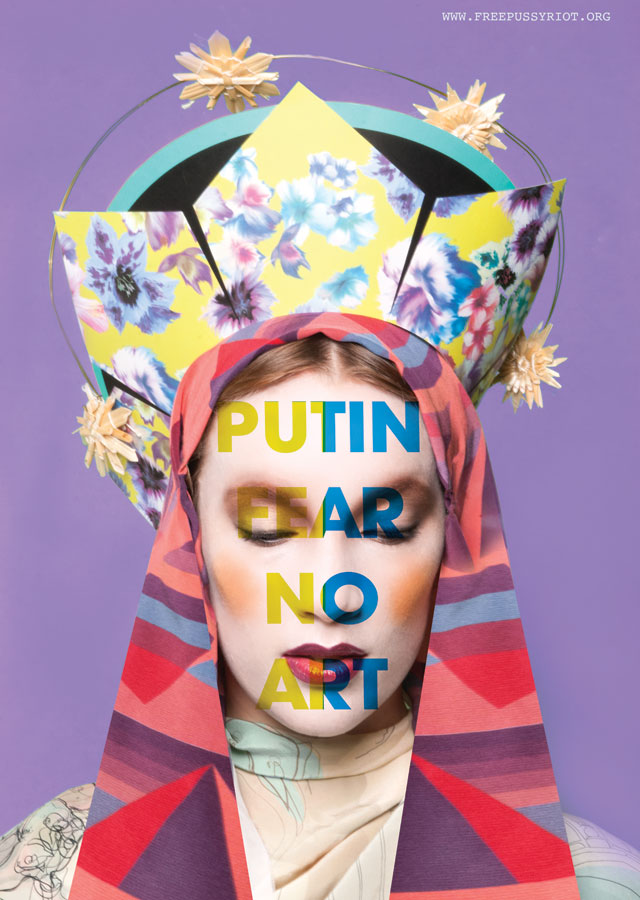
Layla Sailor. Putin Fear No Art, 2012.
AMc: How do you feel about what’s happened to Pussy Riot over the past few years, since they hit the news? Do you worry that they have become too mainstream? The group itself has been in the news for disowning its members for this very reason. Have they moved too far away from the pop-up, unannounced political actions for which they became known, to performing on stage with Madonna and at the Saatchi Gallery and at Summerhall?
TC: They’ve just done their pop-up at the World Cup, so no, not so much. The group’s interrelations are inevitably going to draw the press’s eye, but I think what they’re doing is still relevant to the core of what they stand for. They are pro-LGBT rights, they are eco-warriors and environmentalists, and they’re cool. Fighting for women’s rights and for a woman’s thoughts. None of them veer too far from that as individuals.
AMc: Have you liaised directly with members of Pussy Riot about this exhibition?
TC: Yes, with Nadya. I’ve used some of the drawings by her daughter, Gera. These were also in the book – various drawings from when Gera was a toddler and her mum was in prison. We printed them on newsprint, which makes them look as though they were done only yesterday, in a playgroup or something. I think it’s really important, again, to personalise things, to humanise, to show the woman as well as the politics. We’ve had two female Tory prime ministers in the UK, and the vitriol – it doesn’t matter where you sit on the political spectrum – the vitriol to which they are subjected, the violent chat and the vehemence, it doesn’t compare with the male experience as a premier. There is a sort of dehumanisation if a woman has power.
AMc: Members of the group will be coming to perform 10 nights of Riot Days as part of the programme of live music nights at Summerhall. How integral is performance to the exhibition itself? You’ve mentioned the Gluts, for example, and they are a band.
TC: Yes, I’ve got their OilY film [from 2009] in the womb room. The womb room is an installation that is a curatorial intervention. It’s an encompassing red room – womb room – cinema. It houses works by Carolee Schneemann, the Gluts, No Bra and the Riots themselves inside Moscow’s Cathedral of Christ the Saviour [performing Punk Prayer]. You can watch these things in a completely red room.
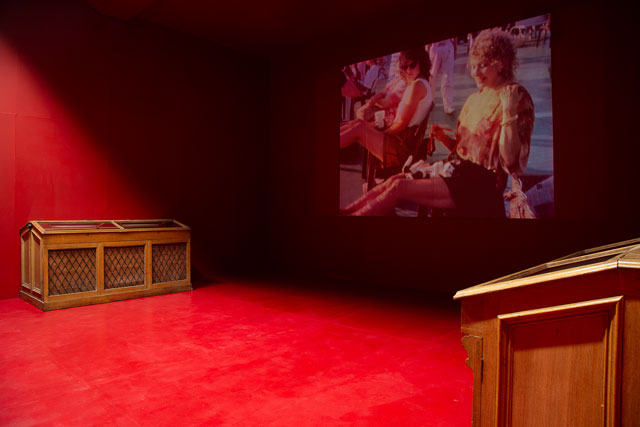
Free The Pussy, installation view. Photograph: Cat Thomson.
The [Let’s Start a Pussy Riot] book is in there, too. I’ve treated it a little bit like a Bible. I shouldn’t say that, but basically there is quite a bit of text at the start, with what they said, their statements at trial, and so on. So, I put copies in these pseudo-religious glass cabinets in the womb room. I love this room. Also, what’s really important is that the womb room is actually in a war memorial gallery, so I have completely changed the room to being one of giving life rather than taking life.
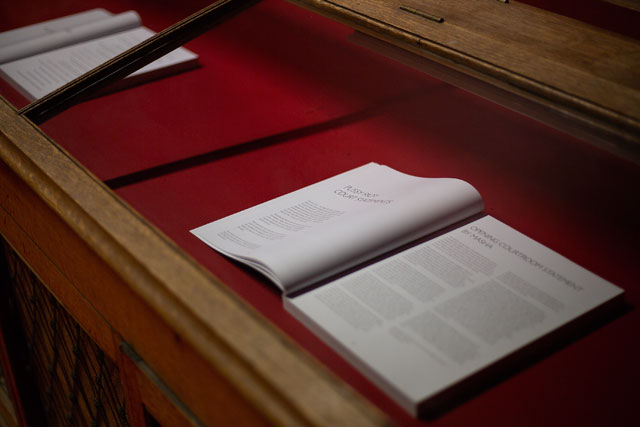
Free The Pussy, installation view. Photograph: Cat Thomson.
AMc: The timing of Riot Days was the reason the exhibition is happening now, but it is also coming on the back of quite an extraordinary year in terms of women’s voices with #MeToo, and all the corollaries of that. How do you think this has affected the way the show might be received, or the message you want to get across?
TC: I think it’s incredibly important. More important, probably, now. You can’t be complacent. I talked about the dangers of social media in my Monoculture project. We’re seeing the red flags over and over again. [Harvey] Weinstein happened and, immediately, he was saying in public: “I’m getting the help I need.” Well, OK, that’s the immediate PR and media-trained response to elicit sympathy from an audience. It took our eye immediately off the ball and turned the response to: “Oh, shouldn’t we feel sorry for Mr Weinstein, whose career is being wrecked by these, let’s face it, slightly unhinged women, who have decided only now to speak out, because, at the time, they were obviously throwing themselves at this media mogul?” It’s a huge problem that we have this immediate backlash. A woman stands up and says: “Hang on a minute. This was wrong what this person did to me. It’s taken me this long to feel able to say anything.” And then, straight away, she gets called – in the same way the Riot did – a whore. Someone even suggested she should be raped again. This is an ugliness that is immediate and that is an issue of our time. It’s an issue of the kind of polarising and back-and-forth that, sadly, I think is what social media promotes. I don’t know what the answer is, but I am concerned about it. The campaigns online are great, but I’m not sure they’re the way that we’re going to really fundamentally change things. I think we have to do it in the flesh world. We have to get these things through government. I think the Riot just need to continue talking about this stuff. Artists need to continue to make work about it – and academics. There needs to be groundswell before there can be real change.
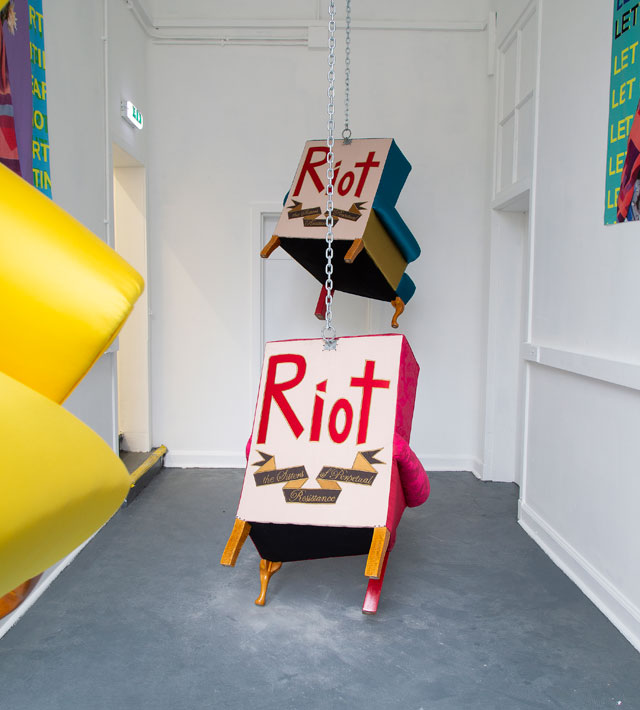
Miss Pokeno. Riot Slut Chairs, 2013. Free The Pussy, installation view. Photograph: Cat Thomson.
AMc: There has been so much happening this year with the centenary of women’s suffrage, as well. It is worrying that, when the year ends, everyone will think: “That’s it, we’ve done that now. We’ve ticked that box. Women can shut up again now for the next century.”
TC: Well, there’s always a danger, isn’t there, of celebrating anything? I think a lot of these things are quite media led and anniversaries are always tricky. It should be a day-to-day thing, doing something, making continual change every day. The Everyday Sexism Project is a good example, but, again, it’s a Twitter phenomenon and I do think it needs to happen in the flesh world because it’s so easy to just say: “This person did this awful thing,” but to then translate that into the bigger realm – bigger change is another matter. There’s a lot of noise out there at the moment. It’s difficult to filter it so that we keep steady. And we need to keep to what will be a critical change.
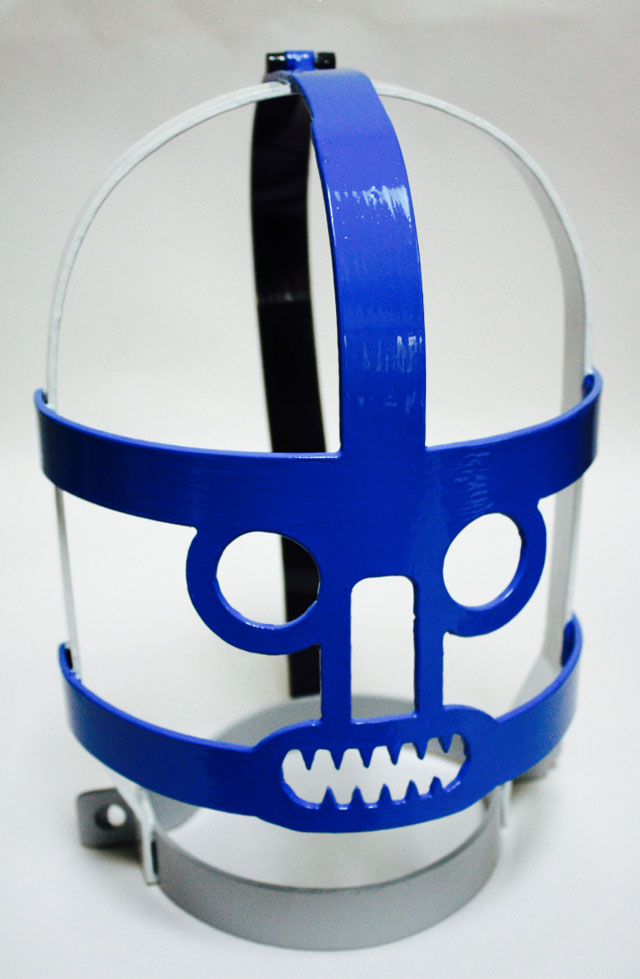
Tamsyn Challenger. Selfie Brank 2 (Twitter), 2013. Fabricated steel, household and polyurethane paint.
AMc: On the subject of change, and the language surrounding it, can you say something about the provocations – intended or otherwise – of using the term “pussy”? And how important is language generally – the language that you are choosing to use, and the language used in some of the artworks?
TC: I think it is fundamental that we reclaim that word from Donald Trump. We must grab our pussy back, or our pussies back. For the duration of the exhibition, I have changed the sign on the Royal Dick pub to the Royal Pussy. Again, a little bit of interventionist art. I think terminology, and how a woman expresses elements of her body, is absolutely her prerogative. I don’t want Donald Trump to have that word. It’s not his word. Fuck you, Donald Trump!
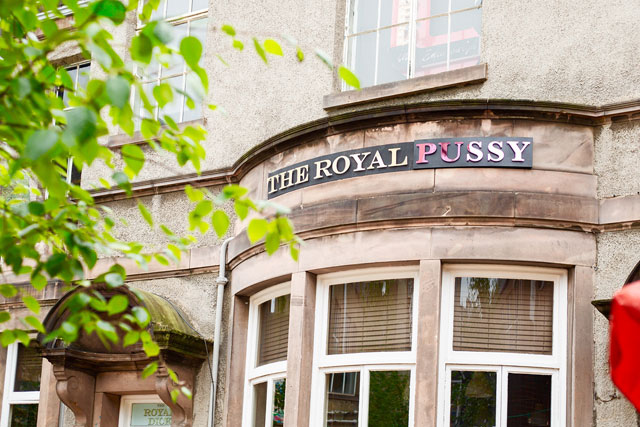
Tamsyn Challenger. The Royal Pussy, 2018. Fabricated metal overlay sign, ply, spray paint.
I think words are incredible. Obviously, the meaning of words alters. There is no shame or fear in that. Loss of words is another matter, but the meaning and the life of a word is beautiful, and we can alter them, and we can reclaim them, and we can define them as we would like them to be defined. For example, I love the term “cunt”. I absolutely adore it. It’s one of my favourite words. I know it’s seen as the filthiest word in the English language, but I embrace the hell out of that. The power in that is amazing. It’s a great joy to me. I’m not suggesting we go into the street screaming it, but, at the same time, I wouldn’t be offended if you did. I love the fact that it’s the most powerful word. I think women can totally own that. How wonderful that a word, which essentially is a female body part, is the most expressive and most violently powerful word we have. Perfect! Now if only that translated into women’s ability to be equally as powerful as their male counterparts in society – or more so, obviously! The term “cunt” is much more powerful than “dick”.
AMc: You have just mentioned renaming the local pub, but can you tell me about your work that is in the show?
TC: Ducking Stool (2012) was a forerunner work of Monoculture. I ended up making a playground of pseudo-sexual torture devices that were painted in Twitter and Facebook colours. I wanted to have a little pop-up object in the [Let’s Start a Pussy Riot] book, but the paper was too expensive. So I ended up making the physical object. It was a crazy moment. I felt very strongly about what was happening to the Riot, because they’d just been arrested, and I thought that there was no finer metaphor for what had happened and for women’s experience anywhere.
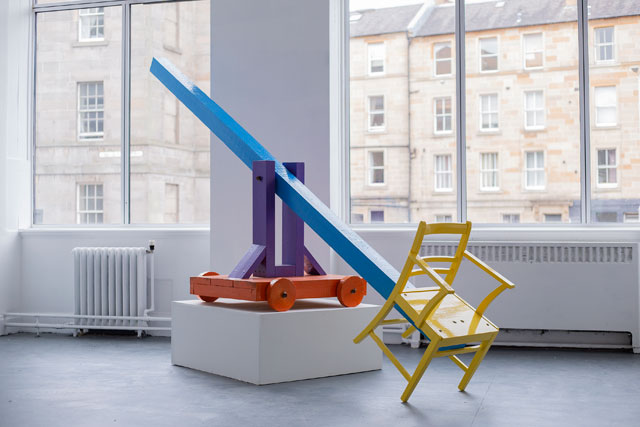
Tamsyn Challenger. Ducking Stool, 2012. Photograph: Cat Thomson.
I think the ducking stool is an extraordinary way of silencing a woman – and it’s not really that long ago in our human history that such things happened. But I find that women are ducked still, constantly. Look at Rose McGowan, Monica Lewinsky, Hillary Clinton – it happens over and over again, if a woman raises her head above the parapet and says: “Hang on, no, that’s not OK.” How is that? That is not fair. I’ve spoken about our two Tory premiers already. I think women are continually ducked if they dare to be successful. If a woman is blazing with creativity or intellect or intelligence, it’s only a matter of time. There’s someone right there, standing willingly, just waiting to hose her down. There’s a long way to go yet.
AMc: And quite often it is another woman who does the hosing.
TC: You know, I veer away from that a little bit. It can be true, but I don’t think necessarily it’s to do with misogyny or being anti-feminist, because it’s almost more feminist to treat a woman equally. If a woman isn’t good at her job, then she should be called on it. I don’t really want to get into women against women because I think it’s counterproductive. And it is what’s used all of the time by men: “Oh, they’re fighting among themselves.” Well, let’s not do that. It’s about personalities – you’re not going to get on with everyone. But, in the workplace, it’s fundamental to try to support women where you can. So, for Free the Pussy!, it was a deliberate decision to have about 80% female artists and 20% male artists, which is the opposite, statistically, of what is generally on show in galleries. I don’t believe in stats, but this one, from the East London Fawcett’s audit, bothered me. We know women are not as valued as men in art and literally not valued on the market in the same way that men are. So, it was a deliberate decision to have 80% female artists on show.
AMc: What are you working on next, once Free the Pussy! is over?
TC: A holiday is what’s next! I’m writing a little bit and I have a number of things I want to do. I’d quite like to just have a tiny bit of a break. I haven’t really stopped since 400 Women. I would like to give my mind a bit of time. There’s been a fair bit of obstruction and controversy around Free the Pussy!, and that’s been quite depressing. It’s been pretty well received, now that it’s on, so that’s a vindication, I suppose. But it’s been hard won, really hard won. I am someone who gets very down with the suppression of work or procreation of ideas. It’s like that Fast Show sketch with the woman who has the idea first, but she’s totally ignored, and then the guys start talking and have the same idea. When the darkness descends, it takes me a little while, but then I become a pulsing vein of fury. What doesn’t kill you makes you stronger. I’m going to dig my heels in further.
• Free The Pussy!, curated by Tamsyn Challenger, is at the Sciennes & War Memorial Galleries, Summerhall, Edinburgh, until 23 September 2018.